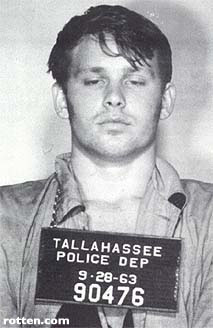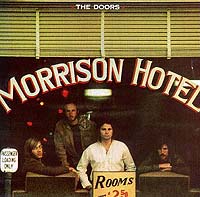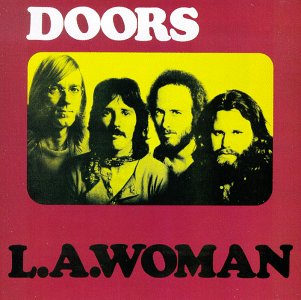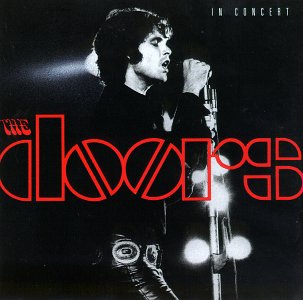|
Jim Morrison He was the Lizard King, and he could do anything. Well, except live past the age of 27. But other than that, sky's the limit! Besides, that whole "death" thing is pretty questionable.
He was the Lizard King, and he could do anything. Well, except live past the age of 27. But other than that, sky's the limit! Besides, that whole "death" thing is pretty questionable. James Douglas Morrison was born in 1943 to a Navy admiral, of all people, and he grew up as an army brat, moving around from base to base and rarely forming lasting friendships. His father was a strict disciplinarian, which just goes to show that strict discipline is a pretty useless parenting technique. As a child, Morrison's family had a jarring experience when they drove past a truck accident in the desert which had killed several Indians, who lay dying along the side of the highway. In Morrison's own words: "Me and my mother and father, and a grandmother and a grandfather, were driving through the desert, at dawn, and a truck load of Indian workers had either hit another car, or just — I don't know what happened — but there were Indians scattered all over the highway, bleeding to death. So the car pulls up and stops. That was the first time I tasted fear. I musta' been about four — like a child is like a flower, his head is floating in the breeze, man. The reaction I get now thinking about it, looking back — is that the souls of the ghosts of those dead Indians... maybe one or two of 'em... were just running around freaking out, and just leaped into my soul. And they're still in there."
Indians scattered on dawn's highway bleeding Ghosts crowd the young child's fragile eggshell mind. By the time Morrison was a teenager, he was showing signs of Lizard Kingliness. In high school (one of his classmates was Mama Cass), he read Friedrich Nietzsche, William Blake and Jean-Paul Sartre, terrorized his teachers and fellow students, and discovered the joys of alcohol. After a brief stint at a Florida college, Morrison trekked to UCLA in 1964, where he studied filmmaking with such prestigious classmates as Francis Ford Coppola and George Lucas. Among the lesser cinematographic lights in attendance was a young hippie named Ray Manzarek, whose chief claim to fame as a director came from convincing his Swedish girlfriend to pose nude in one of his student films. But then, neither Manzarek nor Morrison were destined to be known as filmmakers. The two met on a beach one day, where Morrison was scrawling an ode to a fabulous babe in a bikini, under the title, "Hello, I Love You." Manzarek, a keyboardist, thought the poem was catchy, and a collaboration was born. After some false starts, they recruited drummer John Densmore and guitarist Robbie Krieger, and took the name "The Doors," after Aldous Huxley's "The Doors of Perception."
The Doors got off to a slow start, partly due to the fact that Morrison couldn't "sing" per se, in the sense of carrying a tune. With a lot of practice, he soared to the level of... adequate. But then the technical singing performance wasn't the reason for the band's success. Morrison brought two major qualities to enhance the unquestionably excellent musical abilities of his bandmates: Charisma and dark poetry. Morrison met his soul mate during this period, Pamela Courson, who would give new meaning to the word "long-suffering." The two embarked on a cyclical but long-lasting romance, with elements of codependency, verbal abuse, heavy drug use and rampant philandering.
In 1967, the Doors were signed with Elektra Records and released their first single, "Break on Through." Written by Morrison, the song was a smash hit, drawing critical raves as well as fan adulation. Their second hit, "Light My Fire," written by Krieger, was an even bigger hit later in the year, and their first album went gold. The Doors had arrived. Success didn't agree with Morrison, or rather it agreed with him a little too much. Drunk with power and drunk on whiskey, Morrison began experimenting more aggressively with manipulating crowds, while his personal life wheeled out of control. His estranged family only discovered his new fame from the media; they attended a Doors concert at which Morrison gave a particularly enthusiastic performance of the "fuck the mother kill the father" vignette, and that was pretty much it for the family (until after his death, when they overcame their distaste sufficiently to cash in on the royalties). This was also a time of epic binges, and Morrison decorated the nation from coast to coast in the colors of his vomit and piss. He reportedly had a date with Janis Joplin which left the latter in tears. As the band worked on its second album, Morrison's lyrics took a turn toward the militant, with "Five to One" and "The Unknown Soldier." In concerts and offstage, Morrison became increasingly antagonistic toward authority figures, and in New Haven, CT, he suffered his first in a series of arrests for "public indecency" in concert. Morrison's drinking increased along with the band's success, and Doors concerts were often marred by his drunken incoherence and the damage alcohol was doing to his singing voice. At the same time, however, the Doors successfully began undertaking more ambitious musical projects, such as "The Celebration of the Lizard," a half-hour fusion of music, drama and poetry that left crowds stunned into utter silence by its conclusion.
On a hot night in Miami, in an overbooked concert hall, Morrison's various demons converged to create a spectacle that would haunt the remainder of the Lizard King's days. Drunker than ever, which was saying a lot, Morrison goaded the crowd throughout the concert, at one point directly confronting them with their own adulation for him — You're all a bunch of fuckin' idiots. Letting people tell you what you're gonna do. Let people push you around. (...) Maybe you love it. Maybe you like being pushed around. Maybe you love getting your face stuck in the shit..." After a long chant of "what are you gonna do about it," Morrison followed up by (allegedly) simulating fellatio on bandmate Robbie Krieger, and (allegedly) exposing himself to the crowd. The band left for its next concert date the following morning without a second thought. The usual Morrison antics, perhaps jacked up a notch or two, but then that was what the people were paying to see. Except that the story didn't end there. A story in the Miami Herald about the concert fanned public outrage with what may or may not have been an exaggeration of the obscenity of Morrison's performance (the facts of what happened are still hotly debated, even today). Three days after the concert, the city of Miami filed an arrest warrant for Morrison, charging him with public indecency, profanity and drunkenness. The complaint was filed by an office worker for the state attorney general who happened to be at the concert. Despite the fact that this sort of controversy had been Morrison's bread and butter for three years, the media coverage was brutal and the band took big hits, both in morale and the pocketbook. Major venues either refused to book The Doors or required 5-figure "obscenity deposits," which the band would forfeit in the unlikely (hah!) event that Morrison did anything risque. Jim's response to all this pressure was... you guess it! More drinking! More drugs! Whoo-hoo! Bring it on! He also whiled away the time hanging out with a New York City witch named Patricia Kennealy, whom he married in a pagan ceremony that year in which the happy couple drank each other's blood in a magical ceremony. The wedded bliss came to an end a couple weeks later, and Morrison urged the now-pregnant Kennealy to have an abortion, before riding off into the sunset to reunite with Pamela Courson.
As "L.A. Woman" burned up the charts, Morrison and Pamela Courson decided it was time for a break. According to various accounts, Courson was worried about Morrison's drinking and Morrison was worried about Courson's heroin use. For one or both of these reasons, as well as the mounting toll stardom was taking on Morrison's never-stellar sanity, the two decided to take a break with an extended stay in Paris in 1971, where Jim would focus on his poetry and forget about rock-n-roll for a while. After a life spent before the spotlights, the final act of Jim Morrison's life is shrouded in shadows. There is no clear and undisputed account of what transpired in Paris; Morrison infrequently checked in with his bandmates, and when he did, he seemed upbeat and excited about new ideas for their music. When the music's over, turn out the lights. Morrison was found dead in his bathtub on July 3, 1971. The only person to see his "dead body" was Pamela Courson. She called some kind of doctor, who signed a death certificate illegibly and was never heard from again. The cause of death was listed as a heart attack. The funeral was a closed-coffin affair. No one but Courson (who committed suicide a few years later) and the never- identified doctor ever saw the body. The coffin, whether empty or full, was buried in Paris. Obviously, these are the sort of circumstances which can lead people to reckless and irresponsible speculation. So let's get right to that. There are as many rumors about Morrison's death as there are burnt-out hippies wandering the earth. The most widely accepted of these states that Morrison's death came after a heroin overdose. The problem with this theory is that Jim, while a fan of virtually every drug ever discovered, had a pathological hatred for heroin and frequently battled with Courson over her use of the drug. One variation on this theory states that Courson gave him some heroin to snort and told him it was cocaine. Other theories have Morrison OD'ing on any number of other substances, including cocaine and alcohol, or choking on his own vomit after too much of the same. Further out on the fringe, some claim Morrison was assassinated by the Central Intelligence Agency for being a subversive influence, which seems like a bit of stretch.
Given the unusual circumstances of his death and the dearth of witnesses, the rumor that Morrison lives on has persisted. The surviving Doors occasionally take a shot at capitalizing on the idea by expounding their thoughts, but no one has reported receiving a telegram from Mr. Mojo Risin'. At least, not yet. On the other hand, even if Morrison didn't die in 1971, he would be 60 today. Given his insane habits, it seems quite likely that the Grim Reaper would have caught up with him by now, either through misadventure, overdose or simply bad living. Unless the occasional talk about exhuming the Lizard King's body from its Paris resting place ever comes to fruition, we may never know if and when Jim Morrison broke on through to the other side. But if Janis Joplin is on another crying jag in Rock-N-Roll Heaven, well, that ought to be a good indicator.
Timeline
|
 Certainly, the incident left lasting scars on the young Lizard King's psyche; he would return to the incident again and again in his writing, most famously in the Doors song "Peace Frog":
Certainly, the incident left lasting scars on the young Lizard King's psyche; he would return to the incident again and again in his writing, most famously in the Doors song "Peace Frog": Morrison's preferred method of opening the "doors of perception" was
Morrison's preferred method of opening the "doors of perception" was  While performing at the Whiskey A-Go-Go, an L.A. dive famous as a first stop for future superstars, the band worked out the kinks and discovered Morrison's powerful stage persona. A student of psychology, Morrison was fascinated by crowd dynamics and enjoyed working masses of people into frenzies. Morrison was also a student of obscenity; the Whiskey's management threw the band out on a regular basis for his profanity-laced ad libs, finally firing the band for a particularly florid performance of "The End" in which Morrison chanted "fuck the mother kill the father" for several minutes.
While performing at the Whiskey A-Go-Go, an L.A. dive famous as a first stop for future superstars, the band worked out the kinks and discovered Morrison's powerful stage persona. A student of psychology, Morrison was fascinated by crowd dynamics and enjoyed working masses of people into frenzies. Morrison was also a student of obscenity; the Whiskey's management threw the band out on a regular basis for his profanity-laced ad libs, finally firing the band for a particularly florid performance of "The End" in which Morrison chanted "fuck the mother kill the father" for several minutes.  When reasonably sober, Morrison also became more adept at manipulating crowds; it was not unusual for a Doors concert to end in a near-riot or an over-the-top orgy. Concert hall floors were routinely littered with discarded clothes at the end of a concert, which in turn brought the band under increasing scrutiny by promoters and local authorities.
When reasonably sober, Morrison also became more adept at manipulating crowds; it was not unusual for a Doors concert to end in a near-riot or an over-the-top orgy. Concert hall floors were routinely littered with discarded clothes at the end of a concert, which in turn brought the band under increasing scrutiny by promoters and local authorities.  With a jury composed entirely of people over 40 and a stridently unfriendly judge, Morrison's two-month trial in 1970 was a fiasco which ended in conviction. Morrison filed an appeal as the band finished production on its final album, the critically acclaimed "L.A. Woman."
With a jury composed entirely of people over 40 and a stridently unfriendly judge, Morrison's two-month trial in 1970 was a fiasco which ended in conviction. Morrison filed an appeal as the band finished production on its final album, the critically acclaimed "L.A. Woman."  The best theory about Morrison's death is, of course, that it never happened. Months before the Paris trip, Morrison had talked to friends at some length about his intention to fake his own death, leave his stardom behind and travel to Africa to live among whatever primitive peoples he imagined he could find there. He told people that he would send a message under the pseudonym, Mr. Mojo Risin', an anagram for "Jim Morrison" featured musically in "L.A. Woman."
The best theory about Morrison's death is, of course, that it never happened. Months before the Paris trip, Morrison had talked to friends at some length about his intention to fake his own death, leave his stardom behind and travel to Africa to live among whatever primitive peoples he imagined he could find there. He told people that he would send a message under the pseudonym, Mr. Mojo Risin', an anagram for "Jim Morrison" featured musically in "L.A. Woman."